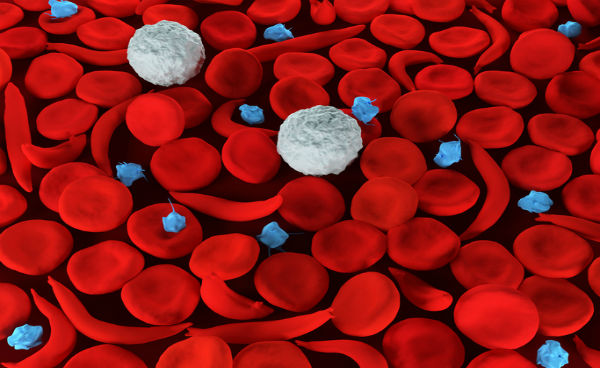 Editors’ Note: Dr. Caterina Minniti was invited by the New England Journal of Medicine to write an editorial about L-glutamine, a drug approved by the U.S. Food and Drug Administration (FDA) last year for the treatment of sickle-cell disease. We asked Dr. Minniti, a professor of medicine and of pediatrics at Einstein and the director of the Sickle Cell Center for Adults at Montefiore, to share her thoughts on L-glutamine and what it means for the treatment of patients with sickle-cell disease. What follows is a transcript of our video Q&A, which has been edited for clarity and brevity. You can also read the editorial.
Editors’ Note: Dr. Caterina Minniti was invited by the New England Journal of Medicine to write an editorial about L-glutamine, a drug approved by the U.S. Food and Drug Administration (FDA) last year for the treatment of sickle-cell disease. We asked Dr. Minniti, a professor of medicine and of pediatrics at Einstein and the director of the Sickle Cell Center for Adults at Montefiore, to share her thoughts on L-glutamine and what it means for the treatment of patients with sickle-cell disease. What follows is a transcript of our video Q&A, which has been edited for clarity and brevity. You can also read the editorial.
Please explain to us what this phase 3 study found, particularly in relation to the FDA’s approval last year of L-glutamine.
Patients with sickle-cell disease suffer from unpredictable, severe pain episodes that decrease their quality of life significantly and cause them to be in the hospital frequently. L-glutamine was able to reduce the number of these pain crises by about 25 percent. Even though 25 percent does not seem like a very large number, when I talked to some of my patients and asked them “Would one fewer crisis a year be significant for you?” they said, “Yes, it would make my life better.”
The approval of a second drug for treatment of sickle-cell disease marks the beginning of the era of combination therapy. Sickle-cell disease is complex; it has multiple and different manifestations in different patients. It is unlikely that the disease can be treated by a single drug. Therefore, the availability of multiple drugs—and we hope many more are to come—will allow us to mix and match and do combination therapy that will let us address all the symptoms of sickle-cell disease and individualize care.
What are the important takeaways that patients should know about L-glutamine?
Patients who suffer from sickle-cell disease should know that L-glutamine has few side effects and can decrease the number of acute-pain episodes and acute chest syndromes (such as severe pneumonia).
Of the patient population with sickle-cell disease, who is most likely to benefit from L-glutamine?
The question of who is most likely to benefit from L-glutamine is still an open one. The phase 3 trial that led to the landmark approval of the drug enrolled a limited number of patients—about 230. Therefore, the researchers were not able to pinpoint which subgroup is most likely to benefit from it. What I have been recommending to my staff is to prescribe L-glutamine to patients who are already taking hydroxyurea (the original approved medication) and still suffer complications from sickle-cell disease, and to patients who are unable or unwilling to take hydroxyurea because they experience side effects or for other reasons.
What additional research needs to be done on L-glutamine?
We still do not know the exact mechanism of action of this drug. It is hypothesized that it reduces oxidative stress. We also need to identify the correct patient population, the right age and the right subgroup. I am sure that many more trials will be coming.
How do you think these findings will affect your clinical practice?
I have already started to prescribe L-glutamine to patients. We have initiated an excellent collaboration with local pharmacies that allows us to prescribe this new medication with a pretty quick turnaround. Our patients have been very enthusiastic in accepting L-glutamine as a supplemental treatment for their disease.
So you see clinical practice and research going hand in hand?
Research means improvement over the status quo and relies on our providing excellent care. I believe that care and research go hand in hand, and both lead to improvements in the lives of our patients. At Montefiore and Einstein we have established a comprehensive sickle-cell center to take care of more than 1,000 patients, with whom we can then discuss participation in research. People asked me frequently if it is difficult to enroll patients with sickle-cell disease in clinical trials. The answer is “No.” If you provide care, then you can do research. Care and research are intimately connected. I find that research elevates the quality of care that patients receive every single time.
You talked earlier about combination therapy for sickle-cell disease. Are there other promising drugs in the pipeline?
Yes. There are many drugs in phase 2 and 3 trials in the pipeline, moving toward approval. They target distinct aspects of the pathogenesis of sickle-cell disease, and we hope they will help attenuate its complications. In the next year or two we may have several new drugs that will help physicians treat patients.
I predict that we’re going to transform sickle-cell disease from a life-threatening condition into a chronic illness that you can live with, like HIV. At the beginning of my medical career, HIV was invariably fatal. In the span of fifteen or so years, a medicine cocktail was developed that basically allows patients who have HIV to live pretty long and healthy lives.
I am quite optimistic about the future of sickle-cell treatment. I felt we needed a jolt—and something to look forward to. That’s why I have spent a lot of time thinking about the title of my editorial about this development. I chose the title “The Dawn of Combination Therapy” because the dawn is the beginning of the day and this medicine is helping us look toward a brighter future.

